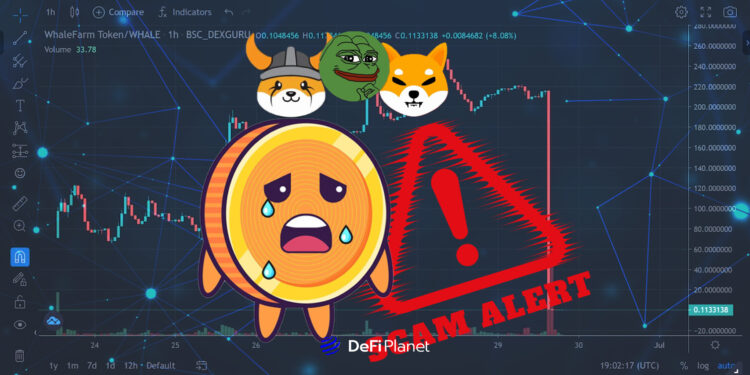Last updated on May 27th, 2025 at 01:16 pm
In the chaotic crypto landscape, memecoins represent its most extreme sector. At times, they turn regular people into overnight millionaires; other times, they leave them broke and full of regret. With so many cautionary tales, you’d expect investors to be more wary. New meme coins launch every day, and people keep throwing their money in.
Look at Argentina’s President, Javier Milei, who recently endorsed the $LIBRA meme coin on social media, claiming it would boost economic growth. Investors jumped in, and the coin’s market cap briefly hit $4 billion. Then, like clockwork, the price crashed, leaving thousands with devastating losses and Milei facing fraud allegations.
Or take the case of influencer Jack Doherty, who allegedly bought large amounts of the McLaren (MCLAREN) meme coin with multiple wallets before hyping it up to his followers. The price soared—until he dumped his holdings mid-livestream, causing it to tank while he walked away with profits.
If meme coins have become a breeding ground for scams, why are people still willing to gamble their savings on them? Are they blinded by greed? Do they underestimate the risks? Or is there something deeper at play? Let’s find out some of these reasons.
The Hype Trap: How FOMO Blinds Investors
In 2024 alone, more than $500 million was lost to meme coin scams, according to Merkle Science. A major driver? Hype-fueled FOMO.
Social platforms like X (formerly Twitter), Telegram, and Reddit are packed with viral success stories—often amplified by influencers—that suggest turning a few hundred dollars into millions is just one meme coin away. This triggers FOMO (Fear of Missing Out), where people buy in not because of research but because they don’t want to miss the next big thing. This emotional pull is so strong it overrides logic
When you see others piling into a meme coin and making fast gains, resisting the urge to follow becomes almost impossible. This is the power of herd psychology. FOMO short-circuits rational thinking. People ignore obvious red flags—anonymous developers, vague roadmaps, or token distributions skewed toward insiders—because they fear missing the next big thing.
TRUMP and PEPE are prime examples. Both coins saw explosive, short-term gains that drew in latecomers chasing returns—only to crash within days. These cycles repeat because people mistake hype for legitimacy and let social proof guide their decisions.
The Illusion of Community: How Scammers Exploit Trust
Many meme coins market themselves as “community-driven” to build trust and lower skepticism. This taps into a psychological need for belonging—people feel safer when they think others like them are part of a shared mission.
But this illusion is often manufactured. Scammers use influencer promotions, group chats, and bot activity to simulate engagement and community growth. Investors mistake this buzz for authenticity.
Once enough people buy in, insiders dump their tokens, and the coin crashes. Investors are left shocked—not just by their losses but by the betrayal of a community they thought was real.
Consider $DADDY, in which on-chain analysis from Bubblemaps revealed significant insider trading after its launch. Insiders allegedly acquired 30% of the token’s supply, worth over $45 million at peak. Additionally, 11 Binance-linked wallets purchased 20% of the supply before the token was promoted on X, allowing select insiders to make huge profits at the expense of everyday investors.
Skipping Research: The Appeal of Easy Wins
In the meme coin world, proper research often takes a back seat. Why? Because the promise of quick returns outweighs the perceived need for due diligence. Many investors think, “If others are making money without reading the whitepaper, I can too.”
This mindset leads people to pour funds into projects with red flags: anonymous developers, no liquidity lockups, unverified teams, and token allocations that heavily favour insiders. But greed—amplified by social media hype—drowns out the warning signs.
What’s often overlooked is how the crypto ecosystem itself incentivizes this behaviour. As we have previously argued multiple times, the race for attention and profits encourages risky launches, influencer shills, and FOMO-fueled investing. Meme coin projects are often designed to benefit early insiders, not long-term holders.
READ MORE:
- The Dark Side of Crypto Incentives: How They Fuel Fraud and Unsustainability
- Crypto Scams Are Never Going Away. Here is Why
People don’t just fall for meme coin scams because they’re uninformed—they fall because the system rewards those who act fast, not those who ask questions.
How Not to Fall for Meme Coin Scams
While meme coins can be fun and even profitable for some, it’s crucial to exercise caution. So how can you check if a meme coin is legit?:
Beware of excessive social media hype
If a coin is being aggressively promoted by influencers but lacks development progress or a clear purpose, it’s likely a pump-and-dump scheme.
Verify the team behind the project
Transparency is key. Avoid projects with anonymous developers, as they can easily disappear with investors’ funds. Research the team members’ backgrounds and previous work in the crypto space.
Examine the whitepaper and roadmap
A legitimate project should have a clear, well-written whitepaper outlining its purpose, technology, and future plans. Be wary of vague, jargon-filled documents or missing whitepapers.
Analyze token distribution, Check for liquidity lockups
A fair token distribution is crucial. If a handful of wallets control most of the supply, there’s a high risk of price manipulation or sudden dumps that can crash the token’s value.
Ensure that the project has locked liquidity, which prevents developers from pulling all funds and abandoning the project (a rug pull).
Tools and Resources to Detect Fraud Before Investing
- TokenSniffer: Scans smart contracts for vulnerabilities, rug pull risks, and copied code from previous scams.
- Etherscan/BscScan: Allows you to analyze wallet holdings, transaction histories, and token distribution for suspicious activity.
- Reddit & Crypto Twitter: Community discussions often uncover scams early. Pay attention to credible analysts and detailed reports.
- CoinGecko & CoinMarketCap: While these platforms list market data, remember that inclusion does not guarantee legitimacy—do your own research.
By following these steps and using the right tools, you can significantly reduce the risk of falling for a meme coin scam and make more informed investment decisions.
Final Thoughts
Meme coin scams keep working not just because people are greedy, but because the ecosystem is built to exploit emotional decision-making. Hype, FOMO, peer pressure, and false promises all play into basic human psychology. Even seasoned investors can fall victim when they feel they’re missing out on the next moonshot. Generally, scams thrive not just because they exist—but because too many people keep thinking this time is different
What makes meme coin scams so persistent is that they look like opportunity—until it’s too late. The crypto world rewards speed, boldness, and hype, but rarely patience or research.
The good news is that you don’t have to be one of the unlucky investors left holding the bag. The next time you see a meme coin skyrocketing overnight, take a step back and ask yourself—who’s really profiting here? Do your research, verify the project, and most importantly, remember that if it looks too good to be true, it probably is. The crypto space will always have its fair share of wild bets and viral tokens, but smart investors know when to ride the wave—and when to walk away.
Disclaimer: This piece is intended solely for informational purposes and should not be considered trading or investment advice. Nothing herein should be construed as financial, legal, or tax advice. Trading or investing in cryptocurrencies carries a considerable risk of financial loss. Always conduct due diligence.
If you would like to read more articles like this, visit DeFi Planet and follow us on Twitter, LinkedIn, Facebook, Instagram, and CoinMarketCap Community.
Take control of your crypto portfolio with MARKETS PRO, DeFi Planet’s suite of analytics tools.





















